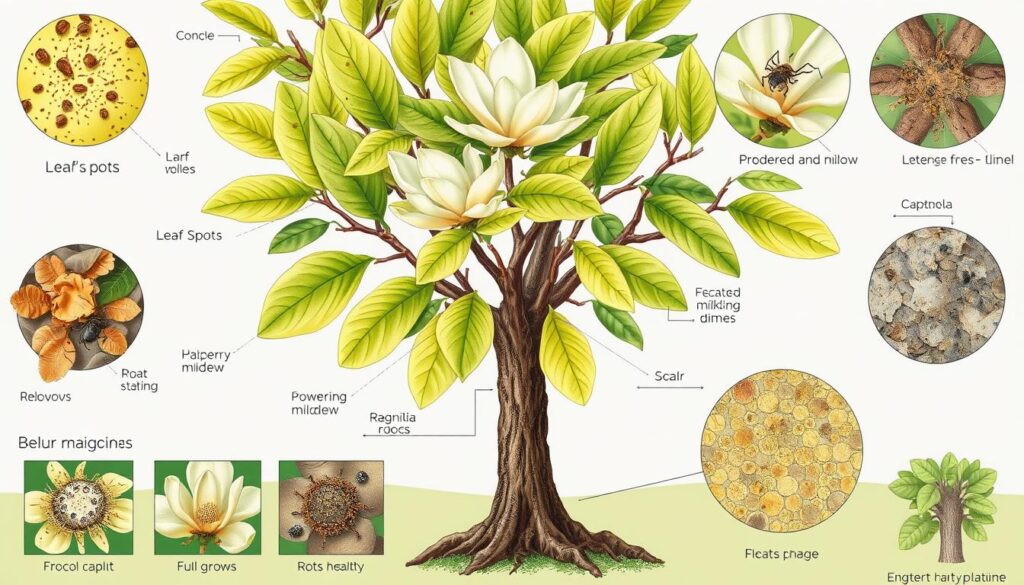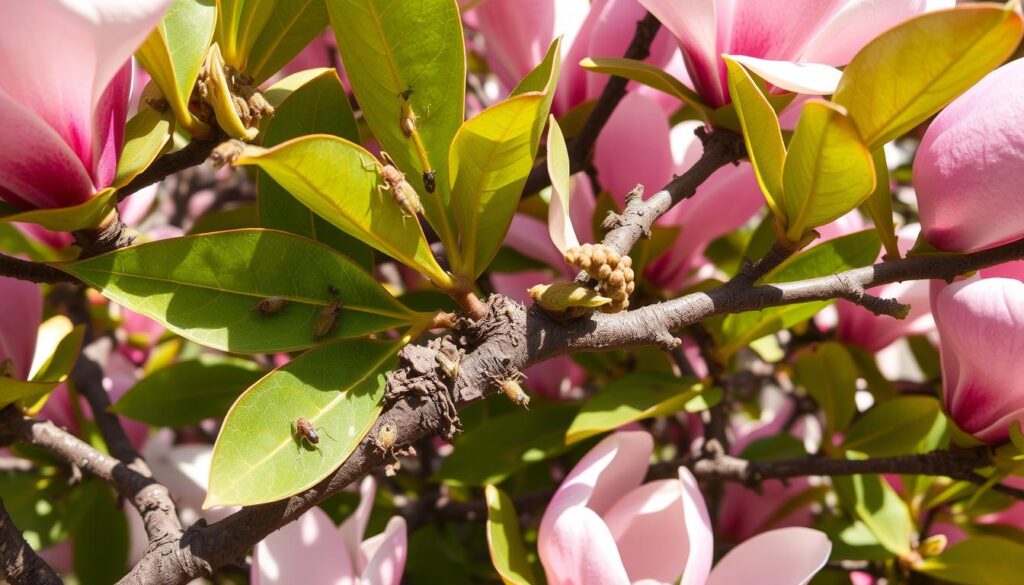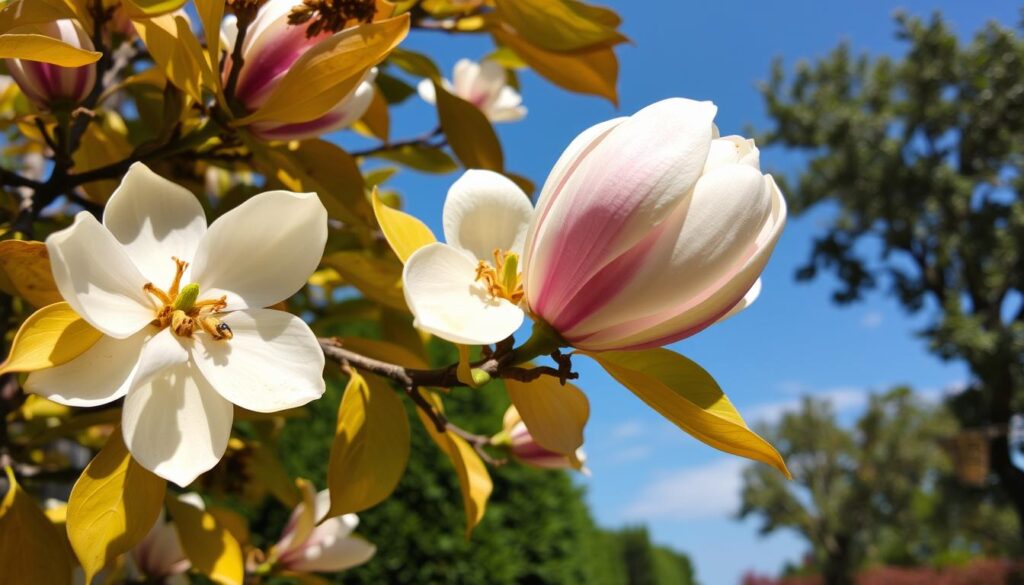Magnolia tree owners face many problems, like diseases and pests. Signs of trouble include discolored leaves and early leaf drop. Knowing what causes these issues helps in caring for the trees.
Leaf spot is a big problem for magnolia trees. It shows as brown or black spots on leaves, leading to early drop. Giving trees the right nutrients can help fight this disease.
To keep magnolia trees healthy, owners should water, fertilize, and prune them regularly. By understanding and preventing common issues, trees can stay beautiful and healthy for years.
Table of Contents
Key Takeaways
- Leaf spot is a common magnolia tree disease that can cause discolored leaves and premature leaf drop.
- Proper nutrition, including the application of a Bio-Stimulant, can help prevent magnolia tree issues like leaf spot.
- Regular watering, fertilization, and pruning are essential for maintaining the health and beauty of magnolia trees.
- Magnolia tree owners should be aware of the common signs of unhealthy trees, including discolored leaves and the presence of fungi or pests.
- Preventive care and maintenance can help reduce the risk of magnolia diseases and magnolia tree problems.
- Understanding the specific needs of different magnolia tree species can help owners provide targeted care and maintenance.
- Professional arborist evaluations can be helpful in diagnosing and addressing magnolia tree issues.
Identifying Magnolia Tree Issues and Warning Signs
When a magnolia tree looks sick, it could be because of pests or diseases. Spotting the warning signs early is key to saving the tree. Look out for leaf color changes, branch and trunk issues, and root problems.
A healthy magnolia tree is less likely to get sick. But, if it does, acting fast is important. For example, learning about common magnolia tree issues can help gardeners catch problems early. Pests like scales and aphids can make the tree weak and more prone to diseases.
Some common diseases include algal leaf spot, anthracnose, and bacterial blight. These can cause leaves to turn yellow or black spots on the trunk. Cutting off infected parts and pruning are key to managing diseases. Knowing the signs and acting early can help keep magnolia trees healthy.
- Leaf discoloration and damage
- Branch and trunk problems
- Root system concerns
Being aware of these issues and taking steps to prevent them can help gardeners enjoy their magnolia trees. Regular checks and care can catch problems early. This reduces the chance of serious damage and keeps the tree healthy.
Understanding Magnolia Tree Health Basics
Magnolia tree care is all about knowing their basic health needs. To keep them healthy and strong, proper magnolia tree maintenance is key. This means pruning, watering, and fertilizing them right.
Planting your magnolia at the right time and place is also important. Bareroot magnolias do best in early spring. Container-grown trees can go in any time during the growing season. Make sure the hole is deep enough for the roots and wide enough to fit the tree.
Use 3-4 inches of mulch to save water and nutrients. This helps your tree grow well.
Prune your magnolia after it flowers to avoid losing next year’s blooms. Check the soil moisture with a “finger test.” Too much water is as bad as too little, so find the perfect balance.
For your magnolia tree to stay healthy, regular care is a must. Keep an eye out for diseases and pests. By following these tips, your tree will thrive and look great for years.
Here are some important tips for magnolia tree health:
- Plant at the right time and in the right place.
- Do the right pruning, watering, and fertilizing.
- Check for diseases and pests often.
- Take steps to stop problems before they start.
Common Diseases Affecting Magnolia Trees
Magnolia trees face many diseases, like fungus, that harm their health and look. It’s key to check them often and care for them right.
Common diseases include leaf spot, Verticillium wilt, powdery mildew, and algal leaf spot. These can come from fungal infections or other causes. They often show up on younger leaves. It’s important to keep air moving around the tree to stop diseases.

To fight these diseases, spot the symptoms early and treat them right. This might mean using fungicides, pruning, or other steps. Fungicides should be used every two weeks. Pruning and watering well can also stop diseases from spreading.
Important steps to prevent and treat magnolia tree diseases include:
- Providing proper airflow around the tree
- Regular pruning and watering
- Applying fungicides as needed
- Monitoring for signs of disease
Knowing about common diseases in magnolia trees, including pests, helps gardeners keep their trees healthy. For serious cases, getting help from a pro is a good idea.
Pest Infestations and Their Impact
Magnolia tree pests, like aphids, scales, and thrips, can harm the tree’s health and look. Magnolia tree insects like the magnolia scale can grow too much. This stresses the tree and causes yellow leaves and dead twigs.
Some common magnolia tree infestations include:
- Aphids: can stunt growth and lead to reduced flowering
- Scales: can reduce nutrient uptake, weakening the tree and potentially leading to sooty mold growth
- Mealybugs: can cause nutrient depletion, making trees increasingly susceptible to diseases
- Whiteflies: can weaken trees by reducing photosynthesis, leading to overall decline in vigor
It’s important to watch magnolia trees closely. Early action can stop small problems from getting worse. Using Integrated Pest Management (IPM) helps keep trees healthy without harming them.

To manage magnolia tree pests well, you must know who they are and treat them right. Understanding magnolia tree insects helps gardeners stop infestations and keep their trees safe.
| Pest | Symptoms | Treatment |
|---|---|---|
| Aphids | Stunted growth, reduced flowering | Insecticidal soap, neem oil |
| Scales | Yellowing of leaves, twig dieback | Systemic insecticides, horticultural oil |
| Mealybugs | Nutrient depletion, sooty mold growth | Insecticidal soap, neem oil |
Environmental Stressors and Their Effects
Magnolia trees face many environmental challenges that can harm their health and growth. Poor magnolia tree soil quality is a big concern. It can cause nutrient deficiencies and damage to the roots. Also, magnolia tree water stress can lead to leaf scorch and flower drop.
To fight these problems, keeping the soil moist is key. You can do this by:
- Checking soil moisture often
- Watering deeply but not too often to help roots grow deep
- Using mulch around the tree to keep moisture in and weeds out
Extreme temperatures, drought, and pollution are other big threats to magnolia trees. Knowing and tackling these stressors helps gardeners protect their trees. This ensures the trees thrive for a long time.

Essential Care and Treatment Solutions
Proper magnolia tree care is key to keeping the tree healthy. This means watering, fertilizing, and treating diseases. For example, a magnolia tree needs water three times a week in warm weather. In cooler weather, it needs water twice a week.
It’s also important to keep the soil pH slightly acidic. You can use peat moss to lower the pH before planting. This helps the tree grow well.
For magnolia tree maintenance, use a balanced fertilizer during the growing season. Regular checks can spot early signs of problems. This lets you treat the tree quickly.
Some important tips for caring for your magnolia tree include:
- Watering regularly, but avoiding overwatering
- Fertilizing during the growing season
- Inspecting the tree regularly for signs of infestations or disease
- Pruning the tree to maintain its shape and promote healthy growth
By following these tips and giving your tree the right care, it will stay healthy and beautiful. Be aware of issues like nutrient deficiencies and poor soil quality. These can cause leaves to turn yellow early. With the right care and treatment, your magnolia tree will bring joy for many years.
Pruning and Maintenance Guidelines
Proper magnolia tree pruning is key to keeping the tree healthy. Prune after it flowers to shape the tree and remove dead branches. Always cut just above a growth node with sharp, clean tools to avoid disease.
Regular magnolia tree maintenance is vital. This includes watering, fertilizing, and mulching. New trees need water every two to three days for the first few months. Older trees should be watered weekly for the first couple of years. Fertilize once a year in spring with a balanced fertilizer.
Some important magnolia tree care tips are:
* Water deeply to promote strong roots
* Mulch to keep moisture in and weeds out
* Don’t over-prune, as it can stress the tree
* Watch for signs of disease or pests
By following these tips and giving your magnolia tree the right care, it will thrive for years to come.
| Magnolia Tree Type | Pruning Requirements |
|---|---|
| Evergreen Magnolias | Prune to remove dead, damaged, or diseased wood |
| Deciduous Magnolias | Rarely require pruning, but may need staged pruning over 2-3 years |
Prevention Strategies for Future Health
Regular checks are key to keeping magnolia trees healthy. By watching the tree closely, gardeners can spot problems early. This helps prevent big issues and keeps the tree in good shape.
Good magnolia tree care means watering right, using the right food, and pruning well. It’s also important to take care of the soil. Healthy soil helps the roots grow strong.
- Seasonal tips, like changing how often you water and when to feed, can stop diseases and pests.
- Managing the soil, by testing and adjusting it, keeps it right for the roots.
- Checking the tree often helps find problems early. This means you can treat them fast and stop them from getting worse.
By using these prevention tips and caring for your magnolia tree well, you can keep it healthy for a long time. This way, your tree will stay strong and beautiful for many years.
Ensuring Your Magnolia’s Long-Term Success
Keeping your magnolia tree healthy for the long term needs a full plan. Knowing common problems, how to care for it, and how to prevent issues helps a lot. With the right care, your magnolia will be a beautiful part of your yard, adding beauty and helping the environment.
Watching your magnolia closely and fixing problems fast is key. Regular checks, quick action on diseases and pests, and the right pruning and fertilizing help a lot. Also, making sure the soil, water, and climate are right for your tree’s needs is important for its growth and strength.
If you’re caring for an old magnolia or planting a new one, this article is here to help. By following these tips, you’ll make sure your magnolia stays healthy and beautiful for years. With proper care, your magnolia will be a joy for generations to come.
Frequently Asked Question
What does a sick magnolia tree look like?
A sick magnolia tree may have yellowing or browning leaves, wilting branches, or sparse foliage. You might notice black spots, powdery mildew, or cankers on the bark. A lack of flowers or slow growth can also indicate stress or disease.
Why does my magnolia tree look like it’s dying?
If your magnolia looks like it’s dying, it could be due to poor drainage, pests, extreme weather, or disease. Root rot from overwatering is common, as well as fungal infections like leaf spot. Drought stress, nutrient deficiencies, or improper pruning can also weaken the tree.
What are the disadvantages of a magnolia tree?
While magnolias are beautiful, they do have some downsides. They shed leaves, seed pods, and petals frequently, creating extra yard cleanup. Their roots spread wide and can be invasive, sometimes interfering with sidewalks or foundations. Some species grow slowly, taking years to mature fully.
Why are my magnolia leaves turning brown and falling off?
Browning leaves can be caused by drought stress, poor soil drainage, or fungal diseases. Sudden temperature changes, frost damage, or too much direct sunlight can also scorch leaves. If the browning starts at the edges and spreads inward, the tree may be dehydrated.
Why does my magnolia tree look bad?
A magnolia tree may look unhealthy due to pests, fungal infections, poor soil conditions, or environmental stress. Aphids, scale insects, and spider mites can weaken the tree, while root rot or leaf blight can affect its appearance. Checking soil moisture, pruning dead branches, and applying mulch can help revive it.
What are the symptoms of magnolia blight?
Magnolia blight, often caused by fungal infections, leads to black or brown spots on leaves, wilting branches, and bark cankers. In severe cases, the tree may lose large amounts of foliage and have a sticky, moldy residue from pest infestations. Pruning infected areas and applying fungicides can help manage the disease.

